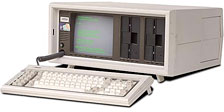Microsoft first shipped Windows 1.0 in 1985, and this DOS shell was content to run even on old 4.77 MHz PCs, albeit slowly. That was also the year Aldus invented the fourth major productivity software category – after word processing, spreadsheets, and databases – by releasing PageMaker. Desktop publishing was born, and Apple found a strong niche market for the Macintosh and LaserWriter.
 Compaq, an early IBM compatible maker and the first to make a portable IBM compatible, shipped the first 80386-based PC in 1986. Compared with the typical 8-12 MHz performance of the 80286, the 16 MHz 80386 was a real barn burner. It also introduced some new operating modes that would make later versions of Windows far more powerful.
Compaq, an early IBM compatible maker and the first to make a portable IBM compatible, shipped the first 80386-based PC in 1986. Compared with the typical 8-12 MHz performance of the 80286, the 16 MHz 80386 was a real barn burner. It also introduced some new operating modes that would make later versions of Windows far more powerful.
 In 1987, Apple introduced expansion slots to the Macintosh in the Mac II (which Apple designed to support a then-mind-boggling 128 MB of RAM), IBM introduced Micro Channel Architecture with its PS/2 line, IBM and Microsoft co-released OS/2, and Windows reached version 1.01. We also saw the first fax cards that year, and Sun shipped the first RISC CPU. (The Acorn Archimedes, another early RISC computer, also shipped in 1987 and may have beat Sun to market.)
In 1987, Apple introduced expansion slots to the Macintosh in the Mac II (which Apple designed to support a then-mind-boggling 128 MB of RAM), IBM introduced Micro Channel Architecture with its PS/2 line, IBM and Microsoft co-released OS/2, and Windows reached version 1.01. We also saw the first fax cards that year, and Sun shipped the first RISC CPU. (The Acorn Archimedes, another early RISC computer, also shipped in 1987 and may have beat Sun to market.)
The fifth major category of productivity software was launched with a program called PowerPoint, originally for Macintosh only. Within three months Microsoft had acquired the company that created PowerPoint, developed a PC version, and made it part of the Microsoft Office suite in 1989 for Macs and 1990 for Windows. Business presentations have never been the same.
Perhaps the most significant computing event of 1988 was the first Internet worm, which infected about 6,000 Unix computers in very short order. Microsoft updated Windows to v2.03, Apple introduced high-density floppy drives compatible with IBM formatted 3.5″ disks, and there were an estimated 30 million DOS users.
 The overall count was about 54 million personal computers in the US in 1989, the vast majority of them running MS-DOS. Apple shipped the heavy (16 pounds!) Mac Portable, the first “notebook” computer with a built-in trackball and possibly the first with an active matrix display.
The overall count was about 54 million personal computers in the US in 1989, the vast majority of them running MS-DOS. Apple shipped the heavy (16 pounds!) Mac Portable, the first “notebook” computer with a built-in trackball and possibly the first with an active matrix display.
Windows moved to Windows 3.0 in 1990, and it was nearly ready for prime time. The first ‘486-based PCs shipped, and Apple trumped the DOS world’s 33 MHz computers with the “wicked fast” 40 MHz Macintosh IIfx, which was also one of the first personal computers to use an accelerated video card.
Linus Torvalds created his own version of Unix, naming it Linux, in August 1991. It remained obscure for a while, but it grew to become the second most popular operating system for Wintel computers and one of the leading examples of free open source software (FOSS) – until Apple moved the Mac OS to Intel in 2006, at which point Linux soon slipped to third place.
Windows 3.1
Microsoft Windows 3.1 shipped in 1992. Between Windows and the hardware of the day, the resources finally existed for Windows to become a major player. Windows soon became the default operating system shipped with new PCs, putting DOS in the back seat.
In February 1993, Apple shipped its 10 millionth Macintosh. The same year Intel introduced its Pentium, a 60 MHz CPU with an undetected math bug, and Microsoft announced there were over 25 million licensed Windows users. By the end of the year, the Apple II line – the granddaddy of personal computers – was discontinued.
 In August 1993, Apple put it first PDA (Personal Digital Assistant) on the market. The Newton MessagePad had about the same footprint as a modern 7″ tablet, was 3/4″ thick, and weighed nearly a pound. It had a 336 x 240 pixel black-on-gray display, so-so character recognition at first, and used a 20 MHz ARM 610 CPU. (Almost every tablet and smartphone made today uses an ARM processor.)
In August 1993, Apple put it first PDA (Personal Digital Assistant) on the market. The Newton MessagePad had about the same footprint as a modern 7″ tablet, was 3/4″ thick, and weighed nearly a pound. It had a 336 x 240 pixel black-on-gray display, so-so character recognition at first, and used a 20 MHz ARM 610 CPU. (Almost every tablet and smartphone made today uses an ARM processor.)
Intel acknowledged the Pentium math bug in 1994 and issued a recall. Apple shipped the first Macintosh with a factory-installed DOS card, the Quadra 610 DOS Compatible. (There had been DOS cards for Macs going back to 1987, but this was the first DOS card to bear the Apple brand and ship from Apple.) This was also the year Apple decided to allow licensed Mac clones and shipped the first Power Macs, Macintosh models based on the then-new PowerPC 601 processor.
Personal Computer History Index: 1975-84, 1985-94, 1995-2004, 2005-14, 2015-Present
Keywords: #pchistory #personalcomputinghistory
Short link: https://goo.gl/9VVCaS
searchword: pchistory

